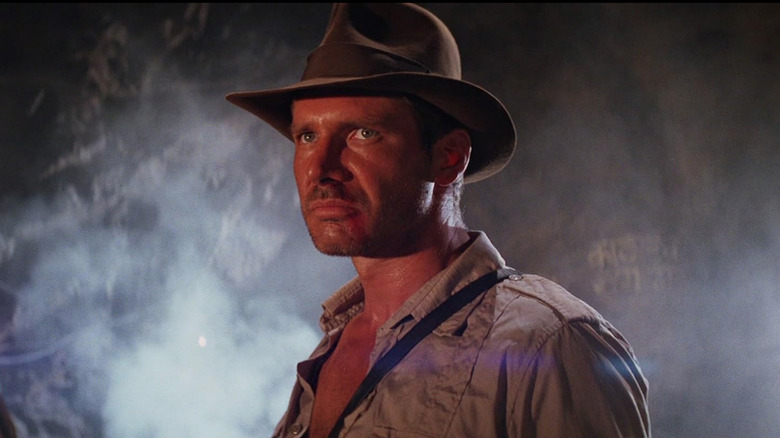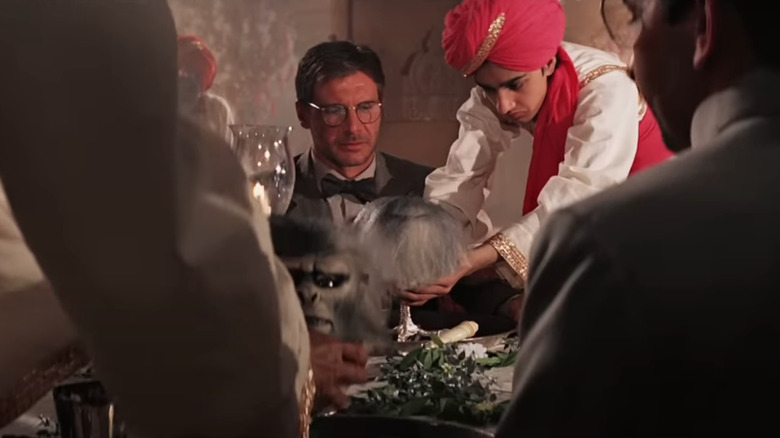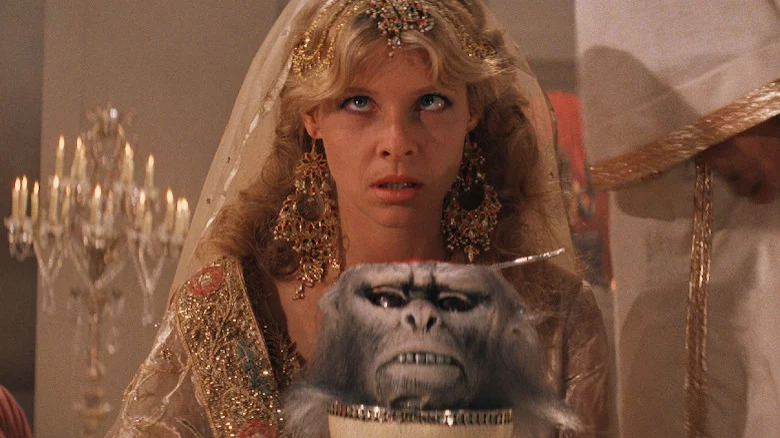What Those Monkey Brains In Indiana Jones And The Temple Of Doom Were Really Made Of
Having scored a hit with the action adventure classic that was 1981's "Raiders of the Lost Ark," George Lucas and Steven Spielberg could easily have just given audiences more of the same for the sequel. But that's not what happened when "Indiana Jones and the Temple of Doom" arrived. Instead of a mostly family-friendly affair, the 1984 follow-up (which was actually a prequel) told a story that was disturbing enough to scare away the writer of "Raiders," Lawrence Kasdan, who was replaced by Willard Huyck and Gloria Katz.
But it wasn't just Kasdan that felt Lucas' story idea was a little too dark. Since the film debuted, Spielberg has stated he likes it the least of all the "Indiana Jones' movies, claiming it to be "too dark, too subterranean, and much too horrific." And with a story that includes child enslavement and sacrifice, hearts being ripped out of chests, and the titular hero being tortured while his child sidekick watches in horror, you can't really blame the director for seeing it that way.
Alongside the more horrifying aspects of Dr. Jones' second outing, there were also plenty of gross-out moments, usually involving Kate Capshaw's nightclub singer Willie Scott, who throughout the film finds herself surrounded by, and often covered in either bugs or snakes. When she wasn't crawling through an insect-infested tunnel, she was being served all-manner of ingeniously repulsive dinner entrée, which required some unique practical effects.
The chilled monkey brains actually sound delish
In "Temple of Doom," after Indiana Jones, Willie Scott, and Ke Huy Quan's Short Round first arrive at Pankot Palace, they sit down to a large banquet, where Indy questions Roshan Seth's Prime Minister Chattar Lal about the sinister Thuggee cult. As the conversation unfolds, a series of unusual dishes, designed to be as nauseating as possible are served, beginning with "Snake surprise" (the surprise is there's more snakes inside). That's followed by a tray of giant beetles before the servers bring out eyeball soup. The grand finale is, of course, severed monkey heads with their skulls handily cracked open to allow the dinner guests easy access to the "chilled monkey brains" inside.
And while Spielberg had made Kate Capshaw work with real bugs and snakes in other scenes, he stopped short of making his actors actually eat real creatures. In a making-of featurette, the filmmaker explained how he conceived of "a meal of the worst stuff you would never imagine eating as long as you would live." And in order to bring that vision to life, he had his crew come up with various practical solutions.
For the soup, rubber eyes were glued to the bottom of the bowl and would float up to the top when Capshaw stirred the broth. Custard also came in handy, especially for the beetles, which were, according to The Prop Gallery, actually made of latex rubber with a detachable section that the crew could fill with the dessert. And for those all-important monkey brains, the crew once again used regular old custard mixed with raspberry sauce.
A joke gone wrong?
"Indiana Jones and the Temple of Doom" wasn't just markedly scarier than its predecessor, it has also been criticized for being culturally insensitive. The banquet scene in particular caused controversy, with Roshan Seth explaining to Empire back in 2012, that he "got a great deal of flak" for that scene "because people kept saying, 'How does an intelligent man like you agree to be in a film which shows Indians dining on beetles and eels?'" But according to the actor, Spielberg intended the whole scene as a bit of a joke, in the sense that "Indians were so f***ing smart that they knew all Westerners think that Indians eat cockroaches, so they served them what they expected. The joke was too subtle for that film."
When the director spoke about the scene during the making of featurette, he seems to have thought of it as merely an excuse for some gross-out comedy. He said: "I think in a way by doing a kind of dark version of the 'Indiana Jones' series, it gave permission to poke some fun of ourselves and have a scene that was really you know towards gross-out comedy."
Ironically, by trying to "poke some fun" at the series, Spielberg ended up making one of the more unsettling entries in the Indy franchise. That is, unless the de-aging shots in "Indiana Jones and the Dial of Destiny" prove to be as terrifyingly uncanny as all the other times Hollywood has tried it.


